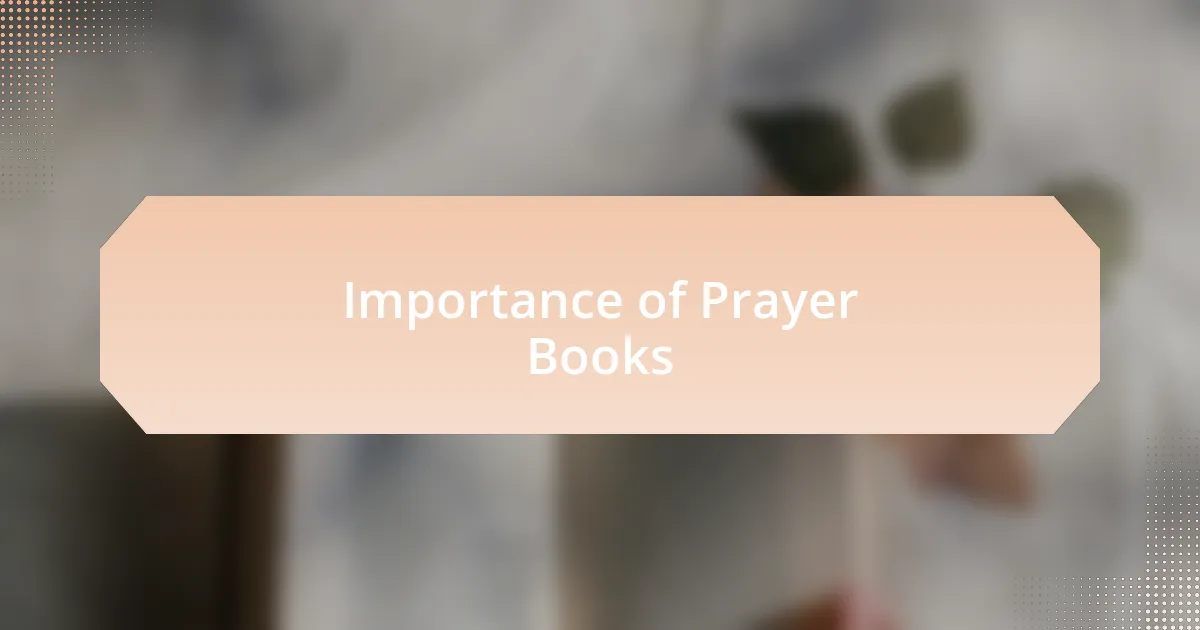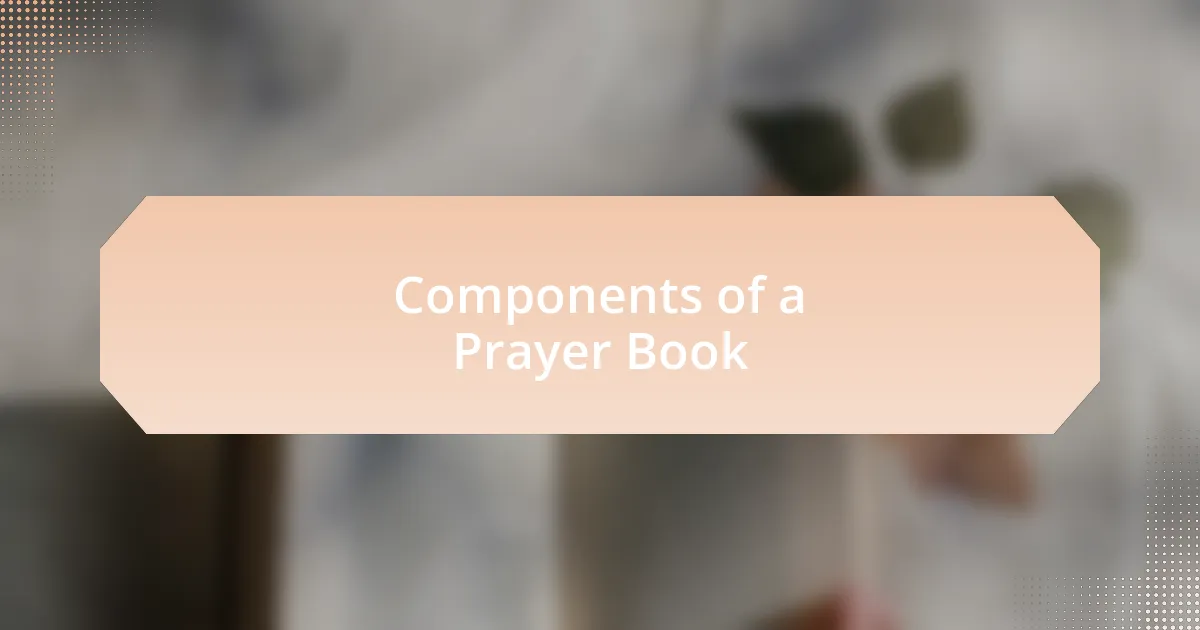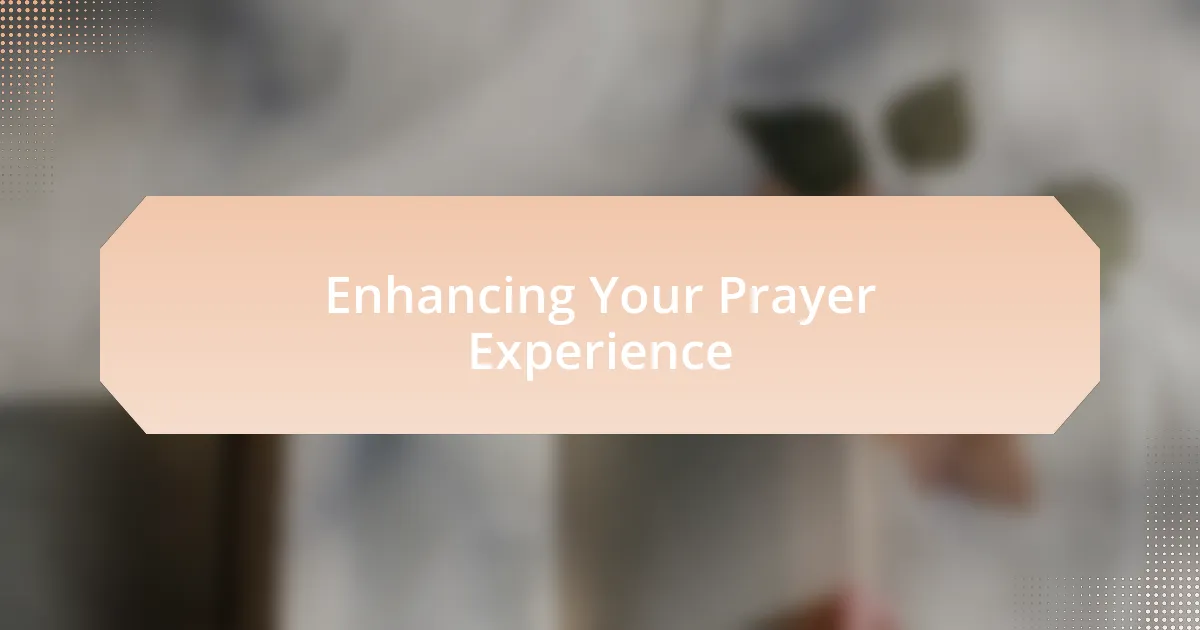Key takeaways:
- Religious books serve as spiritual guides, offering wisdom, introspection, and a connection to personal and communal faith experiences.
- Prayer books are not only collections of prayers but tools for personal transformation, grounding individuals in times of uncertainty.
- Engaging with the components of prayer, such as traditional prayers and personal reflections, enhances one’s spiritual journey and self-awareness.
- Simple rituals, like lighting a candle and maintaining a prayer journal, can deepen the prayer experience and foster connection with one’s intentions.

Overview of Religious Books
Religious books hold a special place in many people’s lives, serving as both spiritual guides and sources of comfort. I remember the first time I opened the pages of my prayer book; it wasn’t just a collection of prayers but a doorway to a deeper relationship with my beliefs. Reflecting on their significance, do you ever wonder how these texts have shaped your own spiritual journey?
These works encompass a variety of scriptures, interpretations, and teachings from different faith traditions, each offering unique insights into the human experience. For instance, the verses in my favorite religious text often resonate with me during challenging times, providing reassurance and direction. Have you felt that pull toward a particular scripture when life feels overwhelming?
At their core, religious books are more than mere texts; they are repositories of wisdom that invite introspection and personal growth. I find that revisiting certain passages sparks new thoughts and emotions, understanding that my interpretation can evolve over time. Isn’t it fascinating how these ancient words can still speak to our present circumstances?

Importance of Prayer Books
Prayer books hold profound significance in many spiritual practices, serving not just as a collection of prayers, but as a companion in our daily lives. I vividly recall a time when I was grappling with uncertainty; my prayer book became a source of solace and clarity, guiding my thoughts and grounding my heart. Have you ever experienced that comforting embrace of familiar words during a moment of turmoil?
The act of praying from a book can create a sense of connection, both to the divine and to those who came before us. I often reflect on the generations that have recited the same prayers, creating a tapestry of shared faith and experience. What does it feel like to you, knowing that your voice joins countless others across time and space?
Moreover, prayer books can act as a catalyst for personal transformation. When I approach specific prayers with intention, I find they inspire me to look inward and identify areas in my life that need healing or change. Isn’t it remarkable how a simple text can illuminate the path toward deeper self-awareness and spiritual growth?

Components of a Prayer Book
When diving into the components of a prayer book, the structure often reflects the depth of its purpose. Typically, you’ll find sections dedicated to various themes, such as gratitude, healing, and supplication. I once stumbled upon a prayer for forgiveness that resonated deeply with me, prompting a wave of reflection on my own relationships. How do we ensure our prayers are both relevant and heartfelt?
Another essential component is a collection of traditional prayers, often revered across generations. These timeless pieces provide a connection to our spiritual ancestors, reinforcing a sense of continuity in our faith practice. I remember the first time I recited a prayer my grandmother taught me; it felt like I was wrapping myself in her wisdom, even after she was gone. Isn’t there something powerful about following a legacy?
Lastly, many prayer books include personal spaces for notes or reflections. This feature enables individuals to jot down thoughts, experiences, or new insights that emerge during their spiritual journey. I find that many of my most profound revelations come not from the prayers themselves, but from the moments of quiet contemplation that follow. How does engaging with your thoughts enhance your prayer experience?

Personal Reflections on Prayer
Prayer is such a personal endeavor, one that has taught me the importance of vulnerability. I often find myself reflecting on my day while I pray, allowing the highs and lows to surface. Have you ever noticed how the act of articulating your feelings can transform anxiety into peace?
One of my favorite moments during prayer is when I set aside time for gratitude. I remember a particularly challenging time in my life when I made it a practice to acknowledge at least one blessing each day. Surprisingly, focusing on the positives shifted my outlook and helped me find joy even in the bleakest moments. Isn’t it incredible how gratitude can serve as a light in dark times?
Engaging with prayer also opens a unique space for introspection. I recall writing down my doubts and fears in my prayer book and considering each one thoughtfully. It turned into a dialogue between my uncertainties and the hope that prayers instill. How often do we allow space for our inner conversations to flourish within our spiritual practices?

Enhancing Your Prayer Experience
Enhancing your prayer experience can often be as simple as introducing a few meaningful rituals that add depth to the process. For me, lighting a candle before I pray creates a serene environment that signals a shift in my mindset. Have you ever noticed how the flickering flame can draw your focus inward, allowing you to truly connect with your intentions?
I also find that incorporating scripture or inspirational quotes into my prayer routine enriches my experience. Recently, I realized how much a single verse could resonate with my current struggles, offering comfort and perspective. It begs the question: how often do we overlook the profound wisdom already present in our sacred texts while seeking solace?
Moreover, I encourage keeping a dedicated prayer journal to record thoughts and insights. Reflecting on past prayers has helped me notice patterns in my spiritual journey, revealing how certain concerns evolve over time. Isn’t it fascinating how our prayers can serve as a mirror, reflecting our growth and shifting priorities?